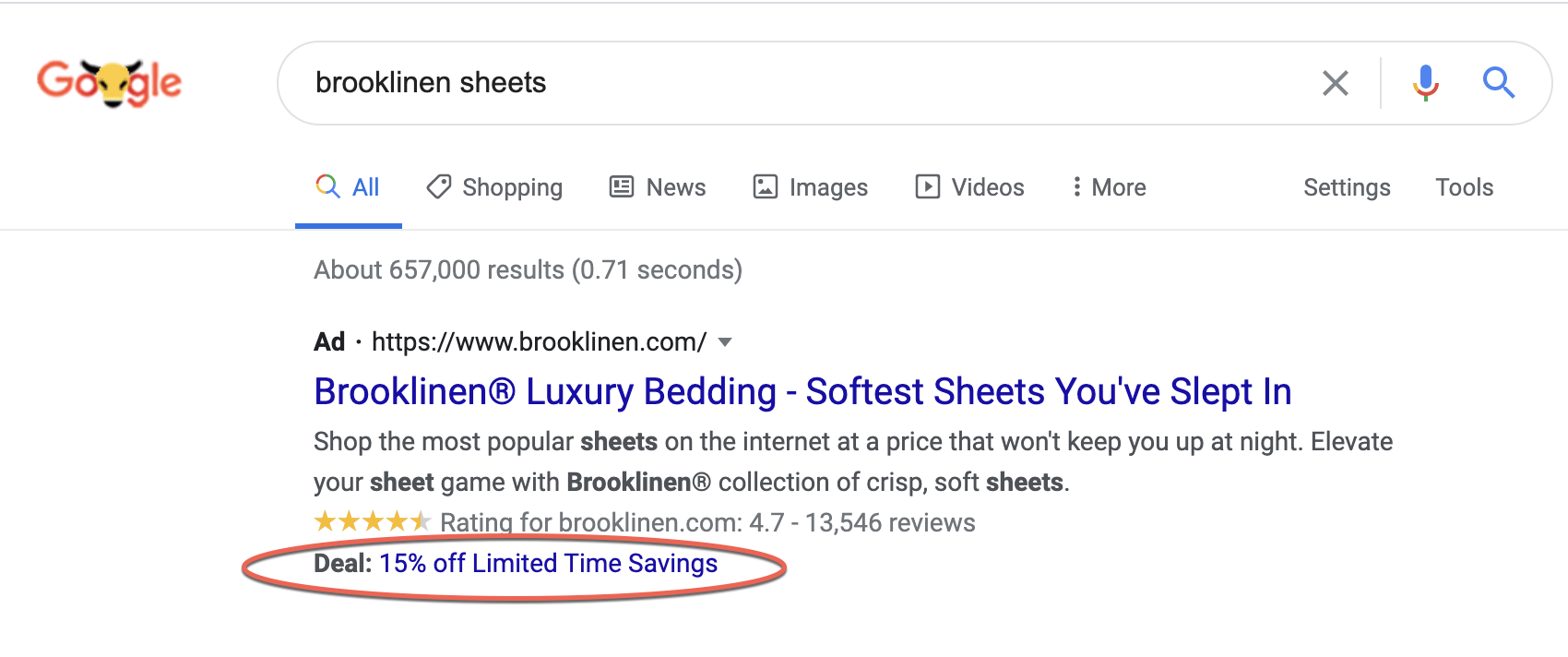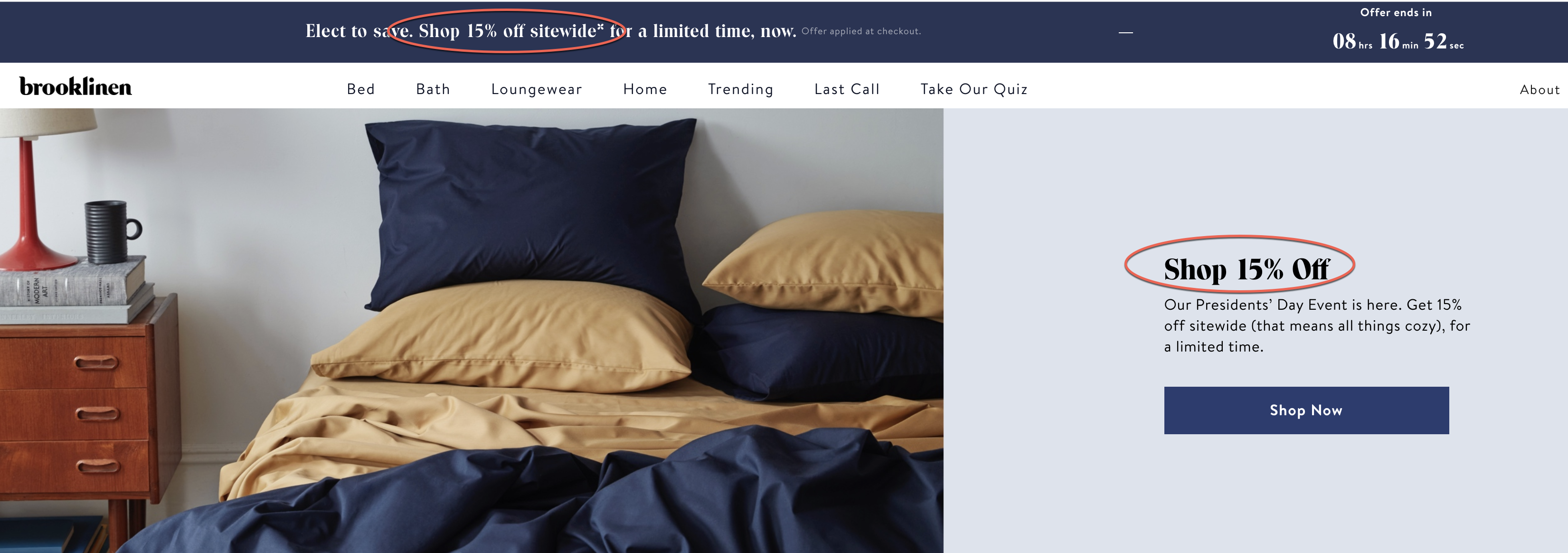So you have a big promotion planned, and you want to advertise it with Google Ads.
What’s the best way to do it?
For many advertisers, the one (and only) thing they’ll do is update the headline and/or body copy of their ads to draw attention to the sale.
But that’s not the only way — or even sometimes the best way — to promote special promotion events.
As the name suggests, promotion extensions are specifically designed to promote special sale events, but they’re often overlooked and undervalued by advertisers.
In this article, I’ll explore the value of promotion extensions and describe how you can use them to get more clicks and conversions – and even include some original research findings.
The Power of Promotion Extensions
Promotion extensions have some real advantages over merely updating ad headlines and body copy with promotional content.
They Give You More Real Estate on SERPs
When you add a promotion extension to an ad, you gain a little bit of extra real estate at the bottom of your ad.
It is little. But every little bit counts on SERPs.
Here’s an example from Brooklinen, with the promotion extension circled in red:

As you can see, the promotion extension gives this ad a little more visual weight.
They Help Your Offer Stand out From the Competition
Having that promotion extension at the bottom of your ad can also help visually differentiate your ad from the competition.
This can give you an edge during competitive promotional events, such as Black Friday – and even most weekends.
Conversion Rates Are Higher for Ads With Promotion Extensions
We recently analyzed ad campaigns for two clients to see where people were clicking to convert.
Here’s what we found:
Client A:
Conversion rates from promotion extension: 13.02%
Conversion rates from sitelink extension: 4.06%
Conversion rates from headline and body copy: 3.66%
As you can see, conversion rates from clicks on ads with promotion extensions were 12.36% higher than ads without the promotion extensions. That’s a lot!
Client B:
Conversion rates from promotion extension: 5.37%
Conversion rates from sitelink extension: 1.99%
Conversion rates from headline and body copy: 1.90%
Promotion extensions performed better here too, converting 3.47% more than headline and body copy clicks.
We took our analysis even further, to see how ads with promotional content performed when compared to those without.
We found for Client A:
Ads with promotional content:
CTR: 14.05%
Conversion rate: 5.52%
Ads without promotional content:
CTR: 9.03%
Conversion rate: 3.63%
Clearly, ads with promotion content performed a lot better.
So messaging “15% off,” etc. can make a real difference – and not just to clicks but also conversions.
Findings were similar for Client B:
Ads with promotional content:
CTR: 15.56%
Conversion rate: 7.63%
Ads without promotional content:
CTR: 8.04%
Conversion rate: 4.37%
Again, Client B had a significant lift with the promo messaging.
They Provide a Direct Path to Your Sales Page
Another benefit of promotion extensions is that they provide a direct path to your sales landing page, so there’s less chance of your lead getting lost between clicking and converting.
Tips for Getting Promotion Extensions Right
So we can all agree that promotion extensions are a valuable tool. But how can you get the most out of them?
Here are some tips:
1. Match Your Promotion Extension to Your Landing Page
As mentioned above, promotion extensions provide a direct path to your landing page, so make sure the copy in your promotion extension aligns with the copy on the corresponding landing page.
This isn’t just good practice, it’s also a Google requirement. As they explain:
Unavailable offers
The following is not allowed:
Promising products, services, or promotional offers in the ad that are unavailable or aren’t easily found from the destination.
Examples (non-exhaustive): Promoting products that are not stocked; promoting a deal that is no longer active; promoting a price that is inaccurate; call-to-action in the ad that isn’t easily available from the destination.
(emphasis added)
In other words, if your promotion extension content doesn’t match your landing page, Google may not approve your ad.
Brooklinen gives us a great example of how to do this right. Remember the ad we looked at above? Here is it again:

Now look at the landing page:

This landing page is in perfect alignment with the “15% off” ad messaging (sale messaging circled in red).
2. Use Start and End Dates
You have the option of assigning start and end dates to promotion extensions.
Unless you plan for your promotion to go on indefinitely, it’s a good idea to use them. Otherwise, you can accidentally run afoul of Google’s rules about unavailable offers (as described above).
Start and end dates also come in handy when you decide to have a short-term promotion at the last minute, say on a Friday for a weekend sale. Instead of changing the heading and body copy, you can choose to just add a promotion extension and set it to expire at midnight on Sunday.
It would be better to have both, of course. But in cases where that’s not possible or convenient, the promotion extension, in and of itself, is very useful.
3. Don’t Forget About Microsoft Ads
Google Ads isn’t the only advertising platform with promotion extensions.
Microsoft Ads has a promotion extension option as well, so don’t forget to use them on both advertising platforms.
4. Use Other Sitelinks
Just because you’re using a promotion extension, that doesn’t mean you can’t also use sitelinks to promote your sale – and you should!
Again, anything that gives you more real estate on SERPs is a good thing.
5. Use Callouts
For the same reason, you should use callouts to promote your sale in addition to everything else we’ve mentioned here.
We often dedicate three to four callouts to promotions. They might say things like, “Big sale,” “50% off,” or “Sale ends Saturday.”
This may seem like overkill, but it’s not. After all, there’s no guarantee that all of these extensions and callouts will appear at the same time.
Therefore, it’s best practice to populate them all – and write them so they’ll make sense alone and in combination.
6. Add Urgency With a Countdown Timer
Google Ads also allows you to add a countdown timer to your ad, which is a great way to add urgency to your promotion.
These are available for text, responsive search, and dynamic search ads.
Don’t Stop at Promotion Extensions
While promotion extensions are awesome, your efforts to promote your sale shouldn’t start and end there.
When you combine promotion extensions with the other features available to you, such as headline, body copy, sitelinks, and callouts, you’ll maximize your promotional efforts even more.
Because while promotion extensions are powerful, they can’t do it all alone.
More Resources:
- A Guide to Every Automated Google Ad Type
- 5 PPC Calls-to-Action Tips & 4 Gotchas You Need to Know
- PPC 101: A Complete Guide to PPC Marketing Basics
Image Credits
Featured image: Dreamstime.com
All screenshots taken by author, March 2021




